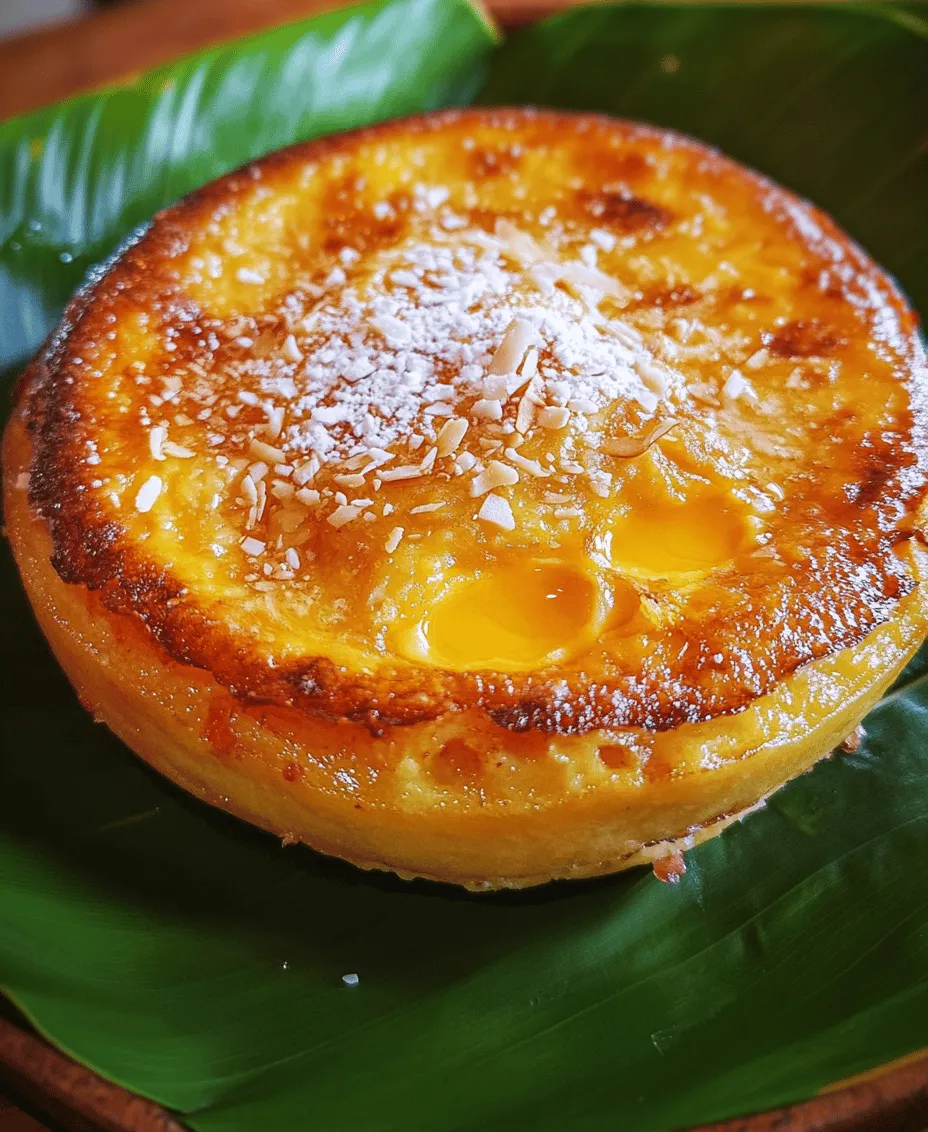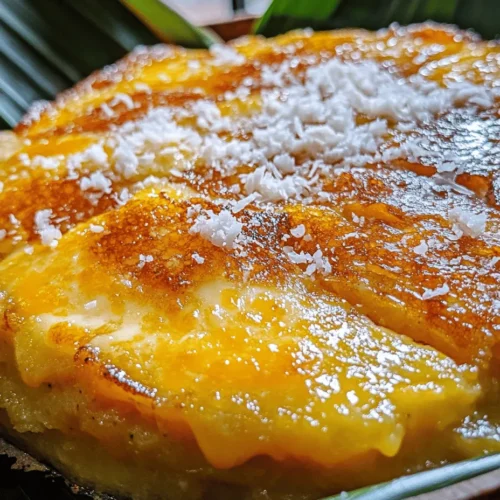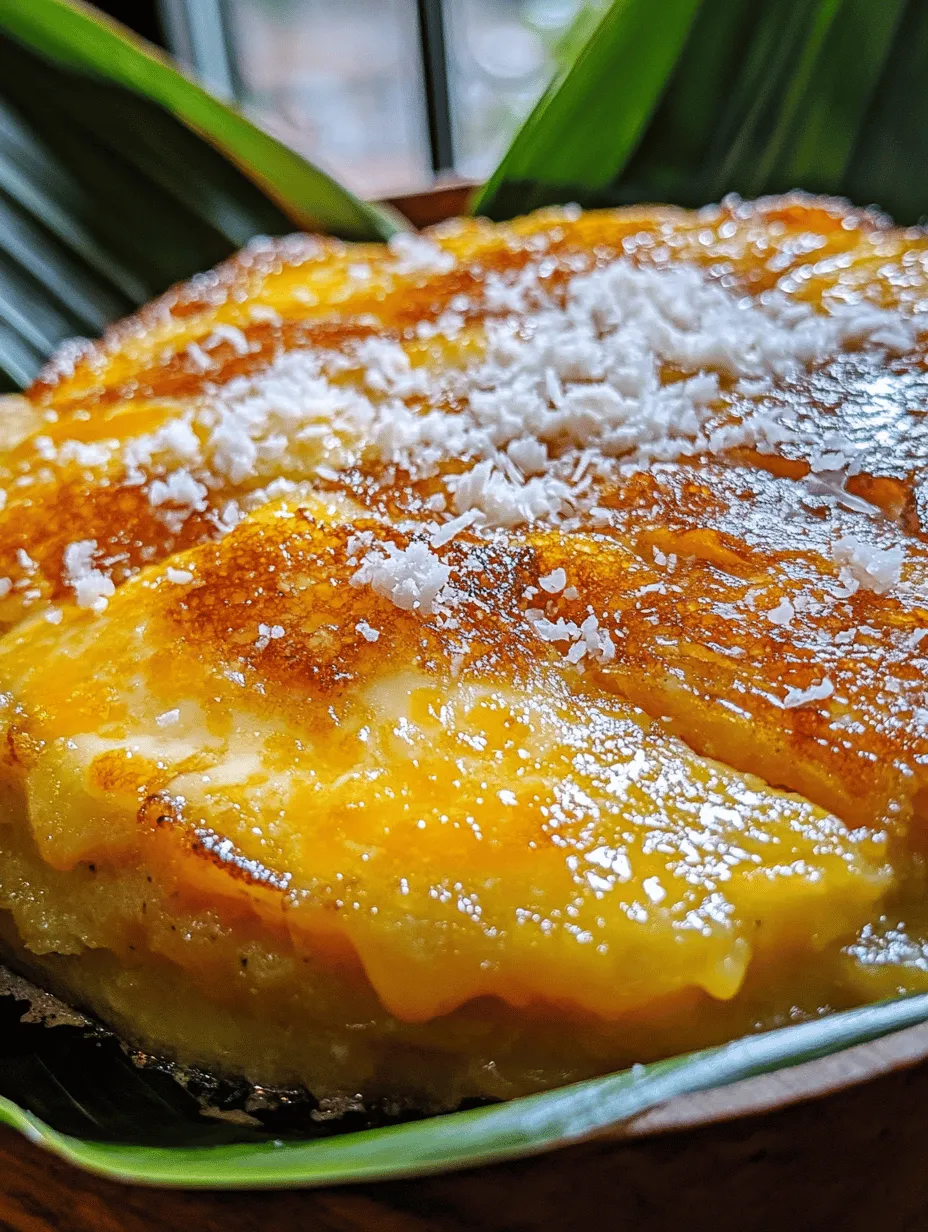Introduction
When it comes to traditional Filipino delicacies, few can compete with the charm and warmth of bibingka. This delightful rice cake, often enjoyed during the festive season, is a staple in Filipino households, combining rich flavors and a unique texture that captivates anyone lucky enough to taste it. Traditionally served warm, bibingka is often associated with Christmas and is sold at street stalls and markets, bringing with it the nostalgia of family gatherings and holiday celebrations.
Bibingka’s significance extends beyond its delicious taste; it symbolizes the rich cultural heritage of the Philippines, showcasing the country’s diverse culinary landscape. Each bite of bibingka tells a story of tradition, community, and the joyous spirit of Filipino festivities. In this article, we will delve into the Warm & Fluffy Bibingka Delight recipe, exploring its unique flavors and textures that make it stand out from other rice cakes.
Prepare to immerse yourself in the delightful world of bibingka, where the sweet aroma of coconut and the taste of freshly baked goodness come together to create an irresistible treat. Whether you’re a seasoned chef or a curious beginner, this recipe will guide you through the process of creating your very own bibingka, ensuring that every bite is filled with love and tradition.
Understanding Bibingka
Historical Background of Bibingka
Bibingka has its origins deeply rooted in Filipino history, dating back to the pre-colonial era. Traditionally, it was made with ground rice and cooked in clay pots lined with banana leaves, giving it a distinct flavor and aroma that is hard to replicate. The cooking method involved using hot coals placed both above and below the pot, allowing the rice cake to steam to perfection while infusing it with the essence of the banana leaves.
Over the years, the preparation of bibingka has evolved, adapting to modern cooking methods and the availability of ingredients. Despite these changes, the essence of bibingka remains the same— a delicious, fluffy rice cake that brings people together in celebration and joy.
Regional Variations of Bibingka Across the Philippines
As with many traditional dishes, bibingka varies significantly across the Philippines, with each region adding its own twist. In Luzon, especially in the provinces of Cavite and Batangas, bibingka is often topped with salted duck eggs and cheese, enhancing its flavor profile. In contrast, the Visayas region may infuse bibingka with hints of pandan or even add a layer of butter for extra richness.
Each variation reflects the local culture and available ingredients, making bibingka a versatile dish that can be personalized to fit different tastes. Regardless of the region, bibingka is cherished as a symbol of Filipino culture and identity.
Common Ingredients and Cooking Methods Used in Traditional Bibingka
The heart of bibingka lies in its simple yet flavorful ingredients. Traditional bibingka consists of rice flour, coconut milk, sugar, and eggs, with some variations incorporating fresh coconut, cheese, and various toppings. The rice flour is crucial for achieving the right texture, providing a chewy yet fluffy consistency that is iconic to this dish.
Preparation methods have shifted with the times, with many now opting for conventional ovens instead of clay pots. However, the fundamental steps remain the same, ensuring that the essence of bibingka is preserved while making it more accessible for modern cooks.
Ingredients Breakdown
Overview of Key Ingredients and Their Roles in the Recipe
In crafting the perfect Warm & Fluffy Bibingka Delight, understanding the role of each ingredient is essential. The following ingredients form the foundation of this beloved rice cake:
1. Rice Flour: This is the primary ingredient that gives bibingka its unique texture. Rice flour is gluten-free, ensuring that the cake remains light and fluffy. It helps absorb moisture from the coconut milk, contributing to the overall softness of the cake.
2. Coconut Milk: A key player in imparting rich flavor and moisture, coconut milk is what elevates bibingka from a simple rice cake to a delightful treat. Its creamy consistency ensures that the bibingka remains moist and flavorful, making each bite a pleasure.
3. Sugar: Adding sweetness, sugar balances the richness of coconut milk and enhances the overall flavor profile of the bibingka. Depending on personal preference, you can adjust the amount of sugar to create a sweeter or more subtle taste.
4. Eggs: Eggs are crucial for binding the ingredients together and adding structure to the bibingka. They also contribute to the cake’s rise, making it fluffy and light.
5. Fresh Coconut and Cheese: For those who seek additional texture and flavor, grated fresh coconut and cheese provide delightful contrasts. They add a chewy element and a salty undertone, making the bibingka even more enjoyable.
Importance of Rice Flour in Achieving the Right Texture
Rice flour is the star of the show when it comes to bibingka. Unlike wheat flour, which contains gluten, rice flour allows for a light and airy texture that is key to the cake’s success. It absorbs moisture effectively, helping to create that signature fluffy consistency that bibingka is known for. As you mix the ingredients, the rice flour will work its magic, turning into a batter that is both smooth and thick, ready to be transformed into a delightful cake.
Role of Coconut Milk for Flavor and Moisture
Coconut milk is what gives bibingka its signature flavor and moisture. The natural sweetness of coconut milk enhances the overall taste of the cake, creating a rich and creamy experience that is hard to resist. Furthermore, it helps to keep the bibingka moist, preventing it from drying out during the baking process. The creaminess of coconut milk also adds a luxurious quality to the bibingka, making it a truly indulgent treat.
Significance of Fresh Coconut and Cheese in Enhancing Taste
Adding grated fresh coconut and cheese to bibingka is a common practice that elevates the dish to new heights. Fresh coconut not only adds texture but also infuses the bibingka with an authentic coconut flavor that is both aromatic and delicious. Cheese, typically a salty variety, provides a delightful contrast to the sweetness of the cake, making each bite a harmonious blend of flavors. The combination of these ingredients results in a bibingka that is rich, flavorful, and utterly satisfying.
Optional Ingredients: Banana Leaves and Salted Duck Eggs
While the core ingredients are essential for a classic bibingka, optional ingredients like banana leaves and salted duck eggs can further enhance the dish. Banana leaves not only serve as a natural wrapper for the bibingka, imparting a subtle aroma, but they also prevent the cake from sticking to the baking dish. If you have access to banana leaves, lining your baking dish with them can add an authentic touch.
Salted duck eggs are another beloved topping, providing a burst of flavor that complements the sweetness of the cake. Their savory profile adds depth to the bibingka, making it a well-rounded dessert that appeals to a wide range of palates.
Preparation Steps
Detailed Description of the Preparation Process
Now that we have a clear understanding of the ingredients, it’s time to dive into the preparation process for our Warm & Fluffy Bibingka Delight. Follow these steps closely to ensure that your bibingka turns out perfectly:
1. Preheat the Oven: Begin by preheating your oven to 375°F (190°C). This is a crucial step, as a hot oven is essential for achieving the right rise and texture in your bibingka.
2. Prepare the Baking Dish: If you are using banana leaves, lightly grease your baking dish with oil or butter to prevent sticking. Then, line the dish with the banana leaves, ensuring that they cover the base and sides. This not only adds flavor but also contributes to the presentation.
3. Mix Dry Ingredients: In a mixing bowl, combine the rice flour, sugar, and a pinch of salt. Whisk the dry ingredients together until well combined, ensuring there are no lumps. This step is vital for achieving a smooth batter.
4. Combine Wet Ingredients: In a separate bowl, whisk together the coconut milk and eggs until fully blended. The eggs should be well incorporated into the mixture, creating a smooth and creamy consistency.
5. Combine Dry and Wet Mixtures: Gradually pour the wet mixture into the bowl with the dry ingredients. Stir gently using a spatula or wooden spoon, ensuring that all the flour is incorporated. Be careful not to overmix, as this can affect the texture of the bibingka.
6. Folding in Eggs and Grated Coconut: If you’re using fresh grated coconut, fold it into the batter at this stage. Gently fold the mixture until the coconut is evenly distributed throughout the batter. This step is crucial for maintaining the light and fluffy texture that bibingka is known for.
7. Pour Batter into the Prepared Dish: Once the batter is well mixed, pour it into the prepared baking dish lined with banana leaves. Use a spatula to smooth the top, ensuring an even surface for baking.
8. Adding Toppings: If desired, place slices of salted duck eggs and a sprinkle of cheese on top of the batter. This step not only adds flavor but also creates an appealing presentation for your bibingka.
By following these steps diligently, you’ll be on your way to creating a warm and fluffy bibingka that is sure to impress family and friends alike. The combination of rich coconut milk, soft rice flour, and the indulgent toppings will create a delightful dessert that encapsulates the spirit of Filipino celebrations.
In the next part of our article, we will explore the baking process, tips for achieving the perfect bibingka, and answers to some common questions about this beloved delicacy. Stay tuned for more insights into this delicious Filipino treat!

Baking the Bibingka
Baking bibingka is a delightful experience that fills your kitchen with enticing aromas reminiscent of Filipino celebrations. To achieve the perfect bibingka, it’s essential to understand the baking process, including the ideal temperature and timing. Preheat your oven to 375°F (190°C). This temperature is crucial as it allows the bibingka to rise and develop its characteristic fluffy texture while ensuring a slight crust forms on the edges.
Once your bibingka batter is poured into the prepared mold, place it in the oven for approximately 25 to 30 minutes. During this time, keep an eye on your bibingka; it’s best to rely on visual cues to determine doneness. When the top of the bibingka becomes golden brown and a toothpick inserted into the center comes out clean, your bibingka is perfectly baked. The edges should pull slightly away from the sides of the mold, indicating that it has set properly.
After baking, allow the bibingka to cool in the mold for about 10 minutes. This cooling period is essential, as it allows the structure to firm up, making it easier to remove from the mold without breaking. For added richness, brush the top of the warm bibingka with melted butter. This step not only enhances the flavor but also contributes to that beautiful, glossy finish that makes bibingka so appealing.
Serving Suggestions
Bibingka is traditionally served warm, often enjoyed as a breakfast dish or a snack, especially during the Christmas season in the Philippines. Filipino households have their unique ways of presenting bibingka, typically garnished with a sprinkle of powdered sugar and a generous serving of grated coconut on top. The sweetness of the sugar and the texture of the coconut complement the soft, fluffy cake beautifully.
For a more festive touch, you might consider adding slices of salted egg or cheese on top of the bibingka before baking. These toppings provide a savory contrast to the sweet, rich flavors of the cake, making each bite a delightful experience.
When it comes to beverages that pair well with bibingka, traditional Filipino drinks like hot chocolate (tsokolate) or a warm glass of salabat (ginger tea) are excellent choices. The richness of bibingka goes well with these warm drinks, enhancing the overall experience of this comforting treat.
Cultural Significance of Bibingka
Bibingka holds a special place in Filipino culture, particularly during festive occasions like Christmas and other celebrations. In many Filipino households, the preparation and enjoyment of bibingka are not just about the food but also about the memories and stories shared around the table. The tradition of baking bibingka often brings families together, where stories and laughter are exchanged, creating bonds that last a lifetime.
During the Christmas season, bibingka is often sold at street corners and markets, where vendors set up makeshift stalls. The sight of steaming bibingka, fresh from the oven, is a common and heartwarming sight during Simbang Gabi (the nightly masses leading up to Christmas). Many families hold annual bibingka-making sessions, passing down recipes and techniques from one generation to the next, ensuring that the cultural significance of this treat remains alive.
Bibingka also serves as a reminder of the communal spirit of Filipino culture, where sharing food is synonymous with sharing love and warmth. Whether at family gatherings or community events, bibingka is a symbol of hospitality and generosity, making it a beloved staple in Filipino traditions.
Health Considerations
While bibingka is a delightful treat, it’s essential to be mindful of its nutritional content. A typical serving of bibingka contains approximately 250 to 300 calories, depending on the ingredients used. It generally consists of carbohydrates, fats, and some protein, primarily from the rice flour and coconut milk.
For those with dietary restrictions, alternatives can be made to enjoy bibingka without compromising health goals. For instance, using gluten-free rice flour can cater to those with gluten intolerance. Additionally, substituting coconut milk with almond milk or low-fat milk can reduce calorie content without sacrificing flavor.
As with any traditional treat, moderation is key. Enjoying bibingka as part of a balanced diet allows you to savor its unique flavors while being mindful of your health. Sharing bibingka during gatherings can also encourage mindfulness about portion sizes, making it easier to enjoy this cherished delicacy without overindulgence.
Conclusion
Bibingka is more than just a delightful dessert; it embodies the joy and warmth that comes from shared experiences and cultural heritage. Its rich flavors and comforting texture make it a beloved dish in Filipino households, especially during festive occasions. By embracing this traditional recipe, you not only indulge in a treat that has stood the test of time but also participate in a cultural legacy that promotes togetherness and community.
As you gather with family and friends, consider making bibingka a part of your celebrations. Whether you stick to the traditional recipe or put your spin on it, sharing this delicious treat can create lasting memories and foster connections. The enduring legacy of bibingka in Filipino culture is a testament to the power of food in bringing people together, creating bonds, and celebrating the warmth of home. So, roll up your sleeves, gather your ingredients, and start baking—bibingka awaits to be enjoyed and shared with your loved ones.



